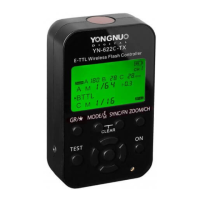The Other YN-622C User Guide v.4.09
11/12/2014 Part 1 – The System Page 10 of 64
622C Flash Controller/Remote
Control by Camera
622C Functions
Simple to Complex setups
• The minimum setup is two (2x) 622Cs, one on camera as a transmitter, and one under a
flash as remote receiver. Any practical number of 622C remotes can be added.
• Lights can be at any angle to the camera, but walls may reduce range.
• Will also sync with most studio flash lighting.
Controller/Trigger Modes
• Full Remote – uses Canon 5-pin hotshoe and camera's built-in External Flash menu.
• Mixed E-TTL and On-Flash Manual – uses Manual settings locally on flash, and the
camera’s remote. E-TTL, FEC, FEB, etc.
• Either mode can have a flash on the camera’s transmitter for ETTL or Manual output levels,
but not as “Master”.
• Basic Trigger – Uses single-pin hotshoe (non-Canon cameras). An adapter may be
needed.
Flash Modes
• E-TTL II, including Flash Exposure Compensation (FEC), Flash Exposure Bracketing
(FEB), Flash Exposure Lock (FEL), Group Ratios A:B.
• Manual output levels, including Manual Group (ALL / A:B / A:B:C).
• Multi (stroboscopic).
Sync Modes
• 1
st
Curtain Sync (1CS); shutter speed up to camera’s x-sync.
• 2nd Curtain Sync (2CS), including using HSS with camera’s Wireless mode disabled.
• High Speed Sync (“HSS”, “FP”). Max. Sync: 1/8000s, depending on camera and flash.
• Super Sync for some non-HSS flashes. The timing of the advanced sync is not adjustable.
Max. Sync Speed: 1/8000s, depending on camera.
• The PC-sync port can output any of these syncs to trigger a studio flash.
• Single-contact camera and single-contact flash sync at max. 1/250s.
Extras
• Reset to Factory defaults [CH+GP].
• Focus Assist Lamp.
• Remote flash zooming (Auto, Manual, local Zoom lock).
• Test-firing of flashes.
• Flash-awaking function, with capable flashes.
• Modelling Flash.
• Live View triggering.
• High-speed continuous shooting triggering, depending on output limits of flash.
• Power supply uses common AA (= LR6, MN1500) alkaline or NIMH batteries.

